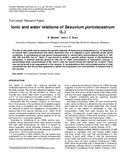| dc.contributor.author | Moseki, B. | |
| dc.contributor.author | Buru, J.C. | |
| dc.date.accessioned | 2011-12-06T10:04:33Z | |
| dc.date.available | 2011-12-06T10:04:33Z | |
| dc.date.issued | 2010 | |
| dc.identifier.citation | Moseki, B. & Buru, J.C. (2010) Ionic and water relations of Sesuvium portulacastrum (L.), Scientific Research and Essay, Vol. 5, No.1, pp. 035-040 | en_US |
| dc.identifier.issn | 1992-2248 | |
| dc.identifier.uri | http://hdl.handle.net/10311/961 | |
| dc.description.abstract | The aim of this study was to assess the growth response of Sesuvium portulacastrum (L.) (a halophyte)
to various NaCl concentrations and hence determine how it is adapted to grow optimally under saline
conditions. S. portulacastrum was grown hydroponically in various NaCl concentrations (that is, 0, 100,
200, 400 and 600 mol m-3 NaCl). It was found to exhibit a growth pattern typical of dicotyledonous
halophytes. It attained maximal growth at 200 mol m-3 NaCl concentration in hydroponic cultures. It
accumulated large concentrations of Na+ and Cl- with the leaves having the highest ion content. These
ions are believed to be sequestered in the vacuole. S. portulacastrum also accumulated proline in high
concentrations and this proline appeared to adjust the cytoplasmic ion concentration to balance that of
the vacuole. | en_US |
| dc.language.iso | en | en_US |
| dc.publisher | Academic Journals, http://www.academicjournals.org/ | en_US |
| dc.subject | S. portulacastrum | en_US |
| dc.subject | Halophyte | en_US |
| dc.subject | Proline | en_US |
| dc.subject | Salinity | en_US |
| dc.title | Ionic and water relations of Sesuvium portulacastrum (L.) | en_US |
| dc.type | Published Article | en_US |
| dc.link | http://www.academicjournals.org/sre/PDF/pdf2010/4Jan/Moseki%20and%20Buru.pdf | en_US |

